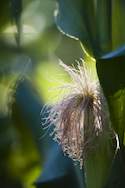Maize Stalk Borer

Here is a list of the predominant insect pests of maize with which maize farmers have grapple. Various other pests also occur that may also cause extensive damages.
The maize stalk borer accounts for more than ten percent of annual crop losses in South Africa.
The young larvae are creamy white with a distinctive grey tinge, sometimes with a pink infusion, according to Grain SA. It has a dark brown head and yellowish brown body, with elongated breathing holes or spiracles. The larvae have four sets of prolegs, all next to each other along the abdomen.
Larvae feed on leaves at the top of the plant, causing characteristic damages that look like shotgun holes. Damages to maize kernels and the leaves may lead to secondary infections that may result in the whole crop being downgraded because of poor quality.
Larvae hibernate as pupae in the base of the stem left as stubble during the winter and emerge as moths after winter, that lay their eggs within the leaf sheaths of young maize plants. Adult moths have a wingspan of 25 to 35 mm. Their forewings are light brown to dark brown with darker markings, whereas the hind wings are white to grey-brown.
The moths usually fly at night at about knee height. They lay eggs in batches of thirty to a hundred, which can usually be seen under emerging maize sheaths.
Cutworms
Cutworms get their name from the way they cut away at the base of seedling stems, which eventually fall over. They do most of their feeding at night, primarily attacking plants during early development. The adult larvae are the most destructive.
Young caterpillars are green, brown, grey or yellow with long stripes, whereas the older caterpillars are much darker. The pupae are brownish-red, but turn black just before the adults emerge. The moths have a wingspan of roughly 45 mm. Their forewings are pale brown to greyish with black lines and irregular markings, while the hind wings are creamy to snow-white in colour.
Black Maize Beetle
The black maize beetle occurs throughout South Africa, but favours cooler areas and sandy soils. Damages are often confused with those caused by cutworms.
The beetles are nocturnal with most damages caused by overwintering adults that feed on maize seedlings planted in spring. Newly emerged adults, however, may also cause damages later in summer.
Damages usually manifests as growth points wilting, resulting in severely affected plants either dying or forming excessive useless tillers at the base of the plant, or the development of yellow stripes on leaves about three to four weeks after planting. Older plants may survive the attack, but growth will be stunted and the plant will be prone to lodging. Damages occur in patches, usually in the raised areas of fields.
The beetles mate underground, with females laying white to creamy coloured eggs that are initially oval-shaped but become rounder and larger as they mature.
The larvae, known as white grubs, develop through three stages and feed on decomposing organic matter in the soil. They are about 2,5 cm long when fully grown, with a light brown head and greyish or creamy white body, except for the hind end that appears black due to the gut contents showing through. They are curled like a horseshoe when relaxed.
Pupae are found in the soil and are pale yellow, but turn reddish brown before adult emergence. The adult beetles have a typical scarab shape and are between 10 to 15 cm long, with a shiny rich brown glossy black colour. They are strong fliers but movement is usually restricted to the soil. The females are slightly larger than the males.